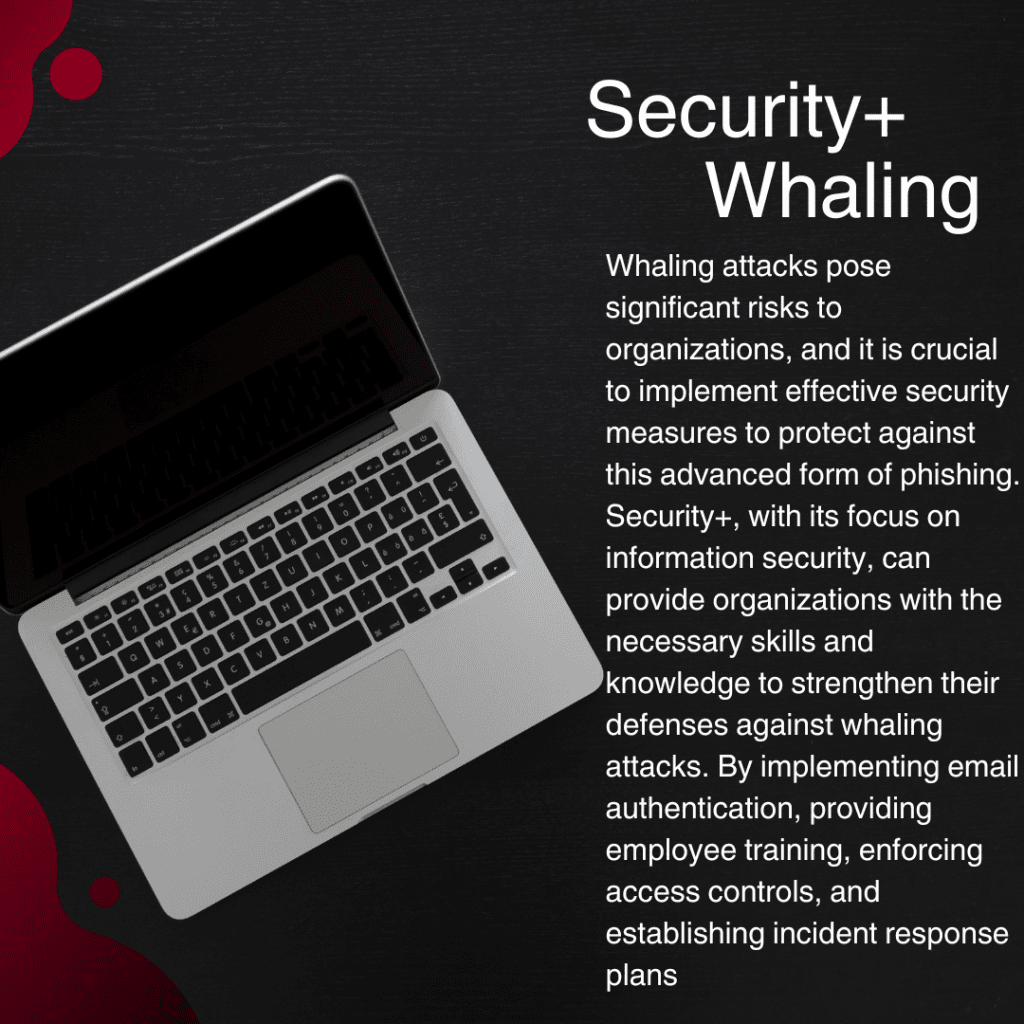Whaling
Phishing attacks, a form of cyber attack where malicious actors trick individuals into revealing sensitive information, have become increasingly sophisticated in recent years. One type of phishing attack that has gained prominence is “whaling,” which targets high-level executives and individuals with access to valuable data or funds. Whaling attacks are highly targeted and personalized, making them difficult to detect and defend against. In this blog, we will explore the concept of whaling, the risks it poses to organizations, and how the implementation of security measures, such as Security+, can help protect against this advanced form of phishing.

Understanding Whaling:
Whaling, also known as CEO fraud or business email compromise (BEC), is a type of phishing attack that focuses on high-profile individuals, such as CEOs, CFOs, and other executives. Unlike traditional phishing attacks, which may cast a wide net and target a large number of individuals, whaling attacks are carefully crafted and highly targeted. Cybercriminals conduct thorough research on their victims, gathering information from publicly available sources, social media, and other online platforms to create a convincing facade. They then use this information to send fraudulent emails that appear to be from a trusted source, often posing as a high-ranking executive or a trusted business partner, in order to trick the victim into taking a specific action, such as transferring funds or revealing sensitive information.
Risks of Whaling:
Whaling attacks pose significant risks to organizations, as they can result in financial losses, reputational damage, and data breaches. High-level executives and individuals with access to critical data or financial resources are prime targets for whaling attacks, as their actions can have a significant impact on the organization. Whaling attacks often exploit the human element of cybersecurity, relying on social engineering techniques to manipulate victims into taking actions that may compromise security. The personalized and convincing nature of whaling attacks makes them difficult to detect using traditional security measures, and organizations need to implement specialized security measures to effectively mitigate the risks.
Whaling Security+:
Security+ is a well-known and widely used certification offered by CompTIA, which focuses on information security and validates the skills and knowledge required to secure IT systems and networks. Implementing Security+ best practices can help organizations protect against whaling attacks by enhancing email security, strengthening authentication methods, and providing employee training on identifying and responding to whaling attempts. Some key Security+ practices that can be applied to mitigate whaling risks include:
- Email Authentication: Implementing technologies such as Domain-based Message Authentication, Reporting, and Conformance (DMARC), Sender Policy Framework (SPF), and DomainKeys Identified Mail (DKIM) can help verify the authenticity of incoming emails and detect spoofed or fraudulent emails.
- Employee Training: Providing regular and comprehensive training to employees, especially high-level executives and individuals with access to sensitive data, on identifying and responding to whaling attempts can help increase awareness and reduce the likelihood of falling victim to such attacks.
- Access Control: Implementing strong access control measures, such as multi-factor authentication (MFA), to limit access to critical systems and data can help prevent unauthorized access in case of a successful whaling attack.
- Incident Response: Establishing a robust incident response plan that includes procedures for detecting, reporting, and responding to whaling attacks can help organizations quickly mitigate the impact of a successful attack and prevent further damage.
Conclusion
Whaling attacks pose significant risks to organizations, and it is crucial to implement effective security measures to protect against this advanced form of phishing. Security+, with its focus on information security, can provide organizations with the necessary skills and knowledge to strengthen their defenses against whaling attacks. By implementing email authentication, providing employee training, enforcing access controls, and establishing incident response plans







